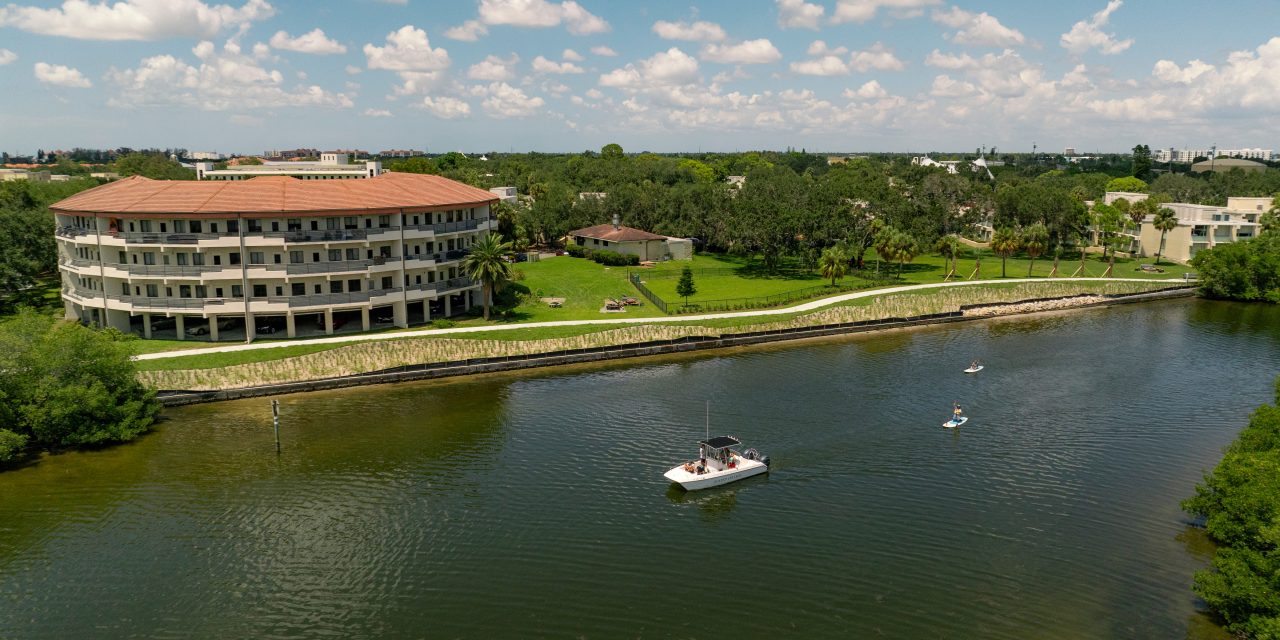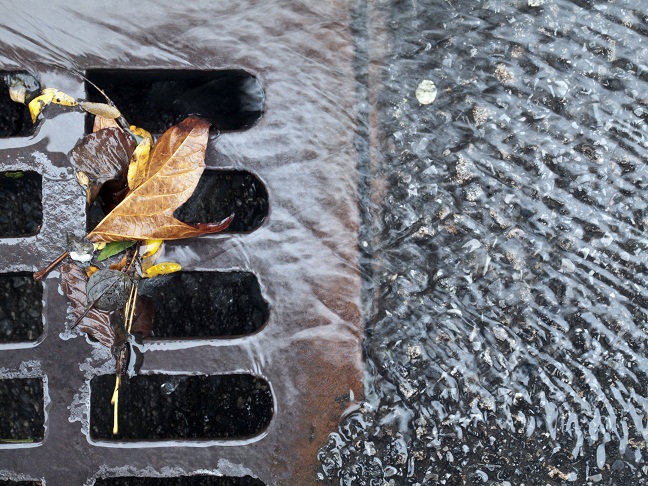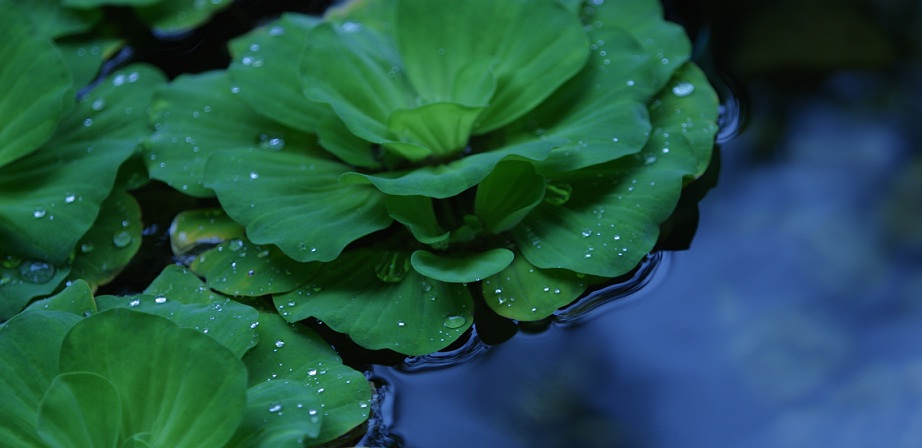Since the days of the Ancient Romans, concrete seawalls have represented the gold standard for environmental engineers seeking to protect coastlines from high tides and storm surges. For evidence, look to the campus of Eckerd College (St. Petersburg, Florida), where an expansive system of seawalls has kept students safe from coastal flooding along Frenchman Creek — an artery of Tampa Bay — for decades.
Seawalls have their drawbacks, however. While durable and reliable when properly designed, most have a limited lifespan of about 20 years before they begin to show signs of wear and tear that diminish their performance. Additionally, rather than letting waves dissipate naturally against the coastline, seawalls tend to bounce wave energy backward toward the water. This can harm the tidal ecosystem over time, particularly affecting seagrasses and the wildlife they support.

Eckerd College is joining a growing number of coastal communities worldwide that are pursuing living shorelines: a nature-based alternative to traditional seawalls that offers sustainable flood protection, minimal maintenance needs, and aesthetic beauty. The Eckerd community, led by Associate Professor of Environmental Studies Jesse Sherry, planted the seeds of its first stretch of living shoreline this summer following more than 3 years of careful planning and design.
“Right now, it’s little sprigs of green coming up through the sand,” Sherry said of the 61-m (200-ft) installation, which replaces a crumbling seawall that had been in place for more than 30 years. “In Florida, we’re deep into the rainy season right now. This is when everything is growing as aggressively as it possibly can. As it continues to rain heavily here until about November, everything will get a chance to get pretty well-settled. Give it a year, and it’ll be ready — it’ll start to look like a really well-established area.”
An Idea Meets an Opportunity
The basic concept behind a living shoreline is using native plants and biodegradable materials to stabilize coastlines, prevent erosion, provide natural runoff filtration, and counteract flooding. While records of intentionally constructed living shorelines date back to the 1970s, the initial idea to implement living shorelines at Eckerd College came from a student less than 10 years ago.
Sherry routinely teaches a Green Design course at Eckerd, acquainting students with new ways of thinking about buildings, products, and energy systems that minimize environmental impact. A key piece of the course tasks students with shepherding a design project from an initial idea to a fleshed-out plan, ready for proposal and implementation. When one student conceived plans for an on-campus living shoreline, Sherry encouraged him to present the idea to Eckerd’s campus planning committee — at the time, however, funding to pursue the idea was sparse.
In 2021, a USD $150,000 grant from the Tampa Bay Estuary Program (TBEP; St. Petersburg, Florida) revived the idea. TBEP identified high-priority areas along the Tampa Bay shoreline, including the Eckerd campus, for projects that would improve water quality. The grant subsidized a lengthy planning and design process meant to maximize the eventual shoreline’s value as both a boon to the bay and an attractive campus fixture.
With a sound plan in place, in 2023, the college secured a USD $350,000 state grant to support implementation. Earlier this year, crews demolished a stretch of crumbling concrete seawall, allowing the Eckerd community space to build back greener.
“After a lot of waiting and planning over the last 3 years, this summer, it all happened kind of explosively,” Sherry said. “Construction work started in June, and it really did not take that long. We were ready for plantings in August, and we had a big student event — more than 80 students came out and helped with the planting, and then we had professionals come in and finish up.”
Conforming to the Shore
The seawall’s influence on the coastal ecosystem is clear at the site of the new living shoreline, which straddles Eckerd’s southern edge just beyond a dormitory and a dog park. Historically, a healthy community of seagrasses thrived along the shore. In many spots, the prolonged force of waves reflected from the former seawall back into the bay had scoured away these grasses. The site’s proximity to busy parts of campus as well as its susceptibility to the powerful waves generated by boats in Frenchman Creek made a linear, one-size-fits-all design for a new living shoreline undesirable. As with most green infrastructure, the performance of the living shoreline depends on its ability to conform to the surrounding geography.
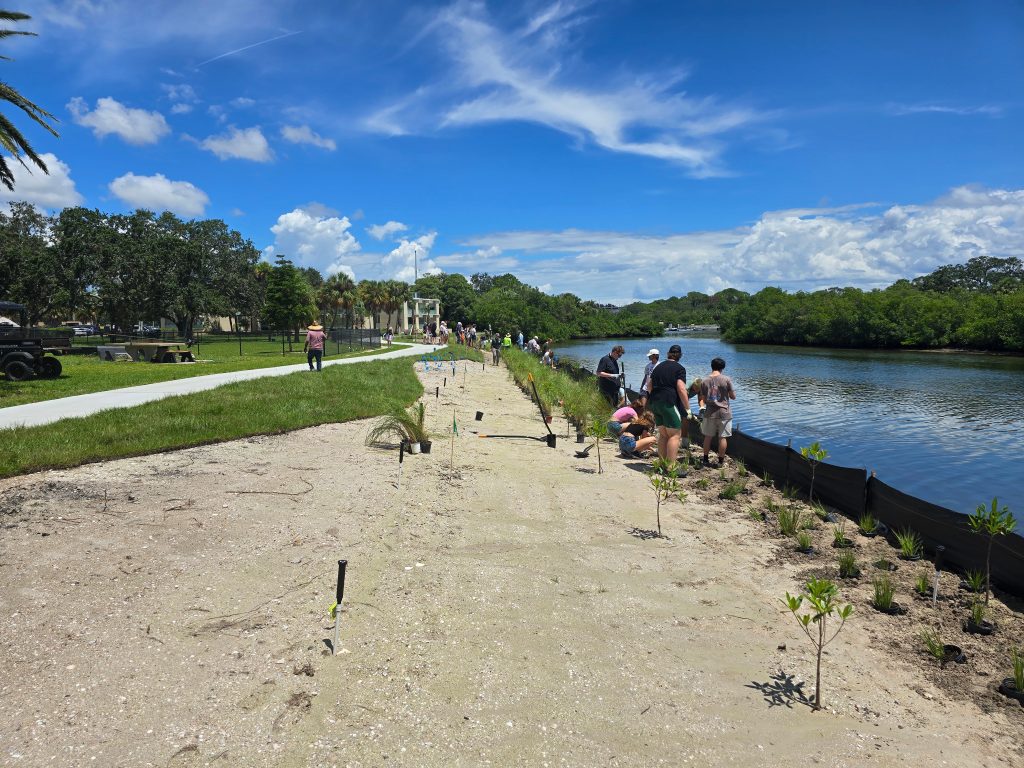
The result is a hybrid design consisting of two distinct sections. The first 30-m (100-ft) stretch features a low, gradual slope designed according to the average high-water line — like a natural beachfront. Along the slope are three separate groupings of seagrasses, each meant to dampen and absorb incoming wave energy. Near the sidewalk, a row of muhly grass will provide a buffer to hamper pedestrian access and discourage disturbances. The beachhead, seeded with a diversity of native plant species of different characteristics, is somewhat of an experiment.
“To a certain extent, the idea is, ‘Let’s see what thrives where,” Sherry said.
A subsequent 30-m (100-ft) section reaches a higher elevation without adequate buildable space to continue a slope. Instead, this section features a terraced design in which a bed of rocks sits below a raised area that will be populated entirely by mangroves. Unlike plants chosen for the first stretch, the mangroves were a deliberate choice based on the iconic Florida species’ unique ability to stabilize coastlines.
“Mangroves are a remarkable species that can hold land in place,” Sherry said. “They can actually somewhat counter sea-level rise because they actually build land up around them. They’re one of the few plant species that grow well and relatively large in salty water.”
Although mangroves are an imperiled species worldwide, they grow quickly and easily, colonizing expansive areas provided they have sufficient room to spread. The challenge — particularly along Florida shorelines — is that they often grow tall enough to obstruct ocean views and wide enough to block beach access, Sherry explained. To strike a balance between people and plants, the team plans to use a pruning process known as windowing to preserve visibility through the adult mangroves’ branches without harming their roots. Within a decade, Sherry envisions that mangroves will cover the entire terraced portion of the shoreline and even might encroach into the currently barren areas created by the previous seawall.
Additionally, the project includes the deployment of pine straw to keep the new plantings in place as they grow, providing stability. Eventually, these grasses will decay and enrich the surrounding soil.
The living shoreline aims to manage not only incoming water, but also outgoing flows.
“Water is a huge challenge on campus,” Sherry said. “About half of our campus is dredge and fill, so it’s about 3 ft above sea level. The other half is about 5 ft above sea level. Water is ever-present, and the challenge we’re facing lately — especially with sea-level rise and increased precipitation — is drainage.”
Included in the living shoreline design is a series of new drains that convey water from on-campus stormwater ponds through the new coastal vegetation and into Frenchman Creek. The seagrasses provide natural filtration, improving both flood resilience for Eckerd and water quality in Tampa Bay.
Intensive Design Nets Sustainable Results
One major difference between seawalls and living shorelines, Sherry said, is that a seawall is strongest on installation day and grows gradually weaker. The reverse is true for living seawalls, which become progressively more effective as plants grow and the surrounding ecosystem reacts.
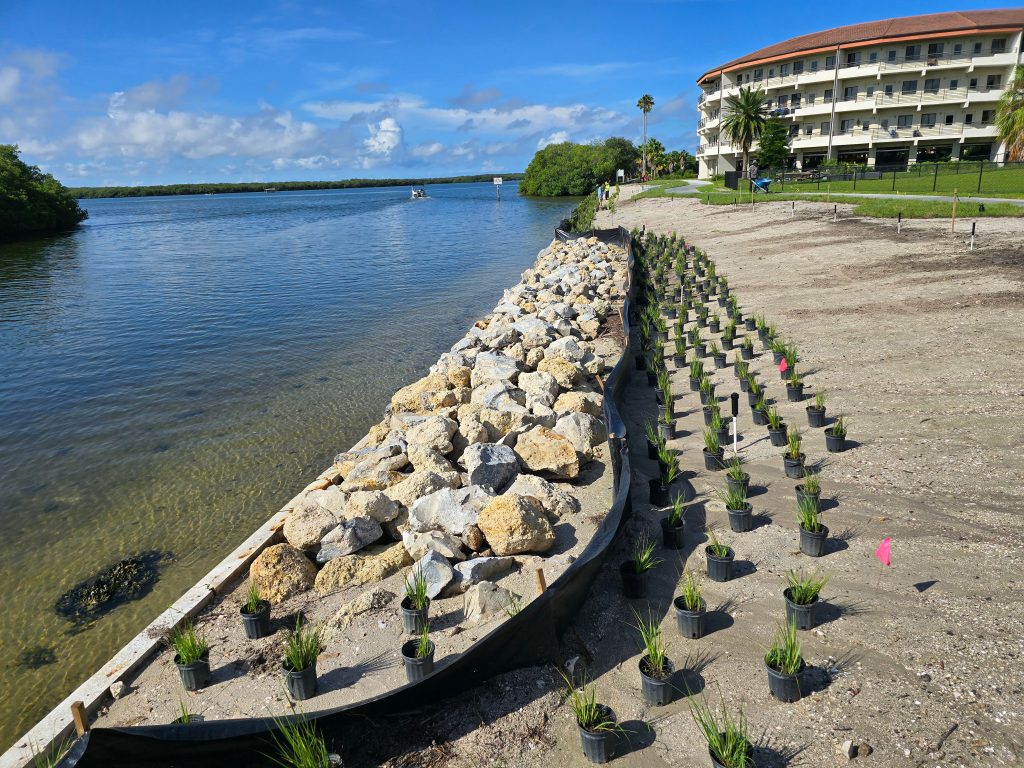
However, despite what living shorelines promise in long-term sustainability, they also demand far more careful planning than gray alternatives. Sherry describes the Eckerd shoreline as a product of extensive input from consultants to balance available space with both human and environmental needs.
“When considering this type of project, know that it takes a lot of expertise throughout the planning and design process,” Sherry said. “That’s probably the biggest difference between doing this and a traditional concrete seawall. You don’t get to just draw a straight line on a map and make it happen. However, this type of design is also much more flexible.”
Although the living seawall is freshly planted, the Eckerd community already is developing grand plans to make the most of their new, living laboratory. Academics, particularly in the biological and environmental fields, will track plant growth closely in search of insights on further ways to work with nature on campus. One marine biologist hopes to install acoustic microphones near the new shoreline to discern whether reduced wave action affects dolphin behavior. And for Sherry and his Green Design students, the living shoreline is poised to provide inspiration for decades to come.
Learn more about living shorelines from the U.S. National Oceanic and Atmospheric Administration.
Top image courtesy of Eckerd College

ABOUT THE AUTHOR
Justin Jacques is editor of Stormwater Report and a staff member of the Water Environment Federation (WEF). In addition to writing for WEF’s online publications, he also contributes to Water Environment & Technology magazine. Contact him at jjacques@wef.org.

